
317 Results

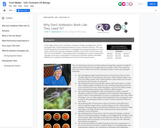
In this high school unit on evolution, students initially investigate the case of young girl with a life-threatening infection of pan-resistant bacteria. This case sparks questions that lead them to investigate the growing prevalence of such cases and the discrepancies between antibiotic use in their communities and CDC recommendations. They expand their investigations to look at population changes occurring in a population of birds (juncos) which exhibit noticeable differences in physical and behavioral traits from the past 60 years.
- Subject:
- Biology
- Science
- Material Type:
- Unit of Study
- Provider:
- iHub
- Date Added:
- 08/19/2019
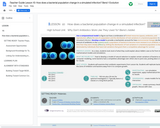
Individual bacteria that have an advantageous trait variation, like fewer pores, have a better chance of surviving exposure to antibiotics, than those without that variation.
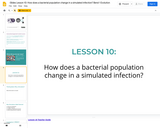
New simulation will add the following features: amount of antibiotics, dosage frequency, variations of bacteria (# of pores) and bacteria reporduction frequency.
- Subject:
- Biology
- Science
- Material Type:
- Activity/Lab
- Provider:
- iHub
- Date Added:
- 08/29/2019
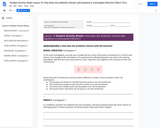
In this next investigation, you will use a model that has many of the same mechanisms in it that it had before. One change to the simulation is the way that the individual bacteria can vary in the starting population. Bacteria don’t just vary based on color; they also vary slightly in the structure of their cell membranes.
- Subject:
- Biology
- Science
- Material Type:
- Activity/Lab
- Provider:
- iHub
- Date Added:
- 08/29/2019
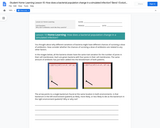
How do you think trait variations among bacteria might be related to which bacteria have a better chance of surviving in Addie or in your Petri dishes when antibiotics are introduced?
- Subject:
- Biology
- Science
- Material Type:
- Activity/Lab
- Provider:
- iHub
- Date Added:
- 08/29/2019
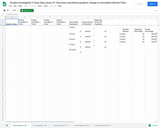
Review spreadsheet data information.
- Subject:
- Biology
- Science
- Material Type:
- Activity/Lab
- Provider:
- iHub
- Date Added:
- 08/29/2019
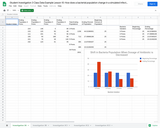
Review spreadsheet data information.
- Subject:
- Biology
- Science
- Material Type:
- Activity/Lab
- Provider:
- iHub
- Date Added:
- 08/29/2019
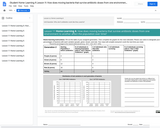
Home-learning Instructions: Fill out the table of your assigned generation. Then complete the graphs for the rows indicated. Please use colors to designate your percentages of bacteria with each variation (purple, green, brown, and red).
- Subject:
- Biology
- Science
- Material Type:
- Activity/Lab
- Provider:
- iHub
- Date Added:
- 08/29/2019

Individual bacteria with trait variations that allow them to survive exposure to antibiotics, reproduce. Over time this leads to a shift in the distribution of traits in bacteria populations, so that those variations become more prevalent over time.

What exactly is changing over time in this experiment?
- Subject:
- Biology
- Science
- Material Type:
- Activity/Lab
- Provider:
- iHub
- Date Added:
- 08/29/2019
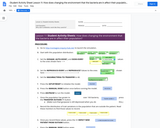
Follow All Procedures A through M to launch the simulation.
- Subject:
- Biology
- Science
- Material Type:
- Activity/Lab
- Provider:
- iHub
- Date Added:
- 08/29/2019
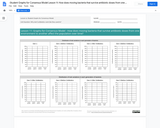
Review all graphs.
- Subject:
- Biology
- Science
- Material Type:
- Activity/Lab
- Provider:
- iHub
- Date Added:
- 08/29/2019

How could the model you made today in class today be used to help answer questions about Addie's condition?
- Subject:
- Biology
- Science
- Material Type:
- Activity/Lab
- Provider:
- iHub
- Date Added:
- 08/29/2019
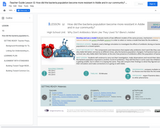
The same interactions and outcomes in the simulation were also at work in Addie's body and also at work in our community over the past ninety years. Bacteria populations became more resistant to being killed by antibiotics as trait distributions in the population that granted them a competitive advantage for survival became more prevalent over many generations of exposure to antibiotics.

How did the bacteria population become more resistant in Addie and in our community? Review lessons/IMTs
- Subject:
- Biology
- Science
- Material Type:
- Activity/Lab
- Provider:
- iHub
- Date Added:
- 08/29/2019
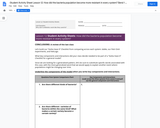
Key Components and Interactions: Look across the three systems from Lesson 9 and pull out the general component and interaction.
- Subject:
- Biology
- Science
- Material Type:
- Activity/Lab
- Provider:
- iHub
- Date Added:
- 08/29/2019
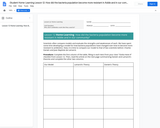
Scientists often compare models and evaluate the strengths and weaknesses of each. We have spent some time developing a model for how bacteria populations have changed over time to become more resistant to antibiotics. Now, it is time to compare our model to that of two scientists before: Charles Darwin and Jean Baptiste de Lamarck.
- Subject:
- Biology
- Science
- Material Type:
- Activity/Lab
- Provider:
- iHub
- Date Added:
- 08/29/2019

Compare and contrast different models.
- Subject:
- Biology
- Science
- Material Type:
- Activity/Lab
- Provider:
- iHub
- Date Added:
- 08/29/2019

Think back to all you’ve done to learn about the evolution of bacteria and the spread of antibiotic-resistant bacteria in this unit.
- Subject:
- Biology
- Science
- Material Type:
- Activity/Lab
- Provider:
- iHub
- Date Added:
- 08/29/2019